Step aside, French Macarons, there’s a new cookie in town! Italian Macarons are crispy, chewy meringue shells paired with sweet fillings that can be flavored as you like. Here's how to make these cute gluten-free treats, complete with step-by-step instructions and troubleshooting tips!

Jump to:
Why this recipe works
- Italian meringue is more stable than French meringue
- It's ok if the macaron shells aren't exactly the same size - just try to get pairs that match up
- You can choose whatever filling you'd like
Macarons are dainty little confections with crisp outer shells and chewy seductive centers. At their base, the cookie shells feature little ridges called “feet” that are the mark of a well-made macaron.
(Side note: if you just say Macaroons, people think you mean the treats made with coconut flakes. These are definitely not those!).
And their reputation as a finicky cookie are well noted. One place where bakers can get tripped up is making the meringue, so having a way to stabilize the meringue can help.
Enter the Italian Meringue Macaron (or maybe just Italian Macaron).
⭐⭐⭐⭐⭐
Simply the best and most reliable way to make macarons! With French meringue macarons in the past I had maybe a 30-40% success rate, but so far I've made these three or four times and it has always worked! I even made a chocolate version by mixing in dark cocoa powder and they were delicious!
- Ella
Recipe Ingredients
The ingredients used in an Italian macaron recipe are the same as for French macarons. The difference is just how you prepare the meringue. You'll need the following ingredients to make this macaron recipe:
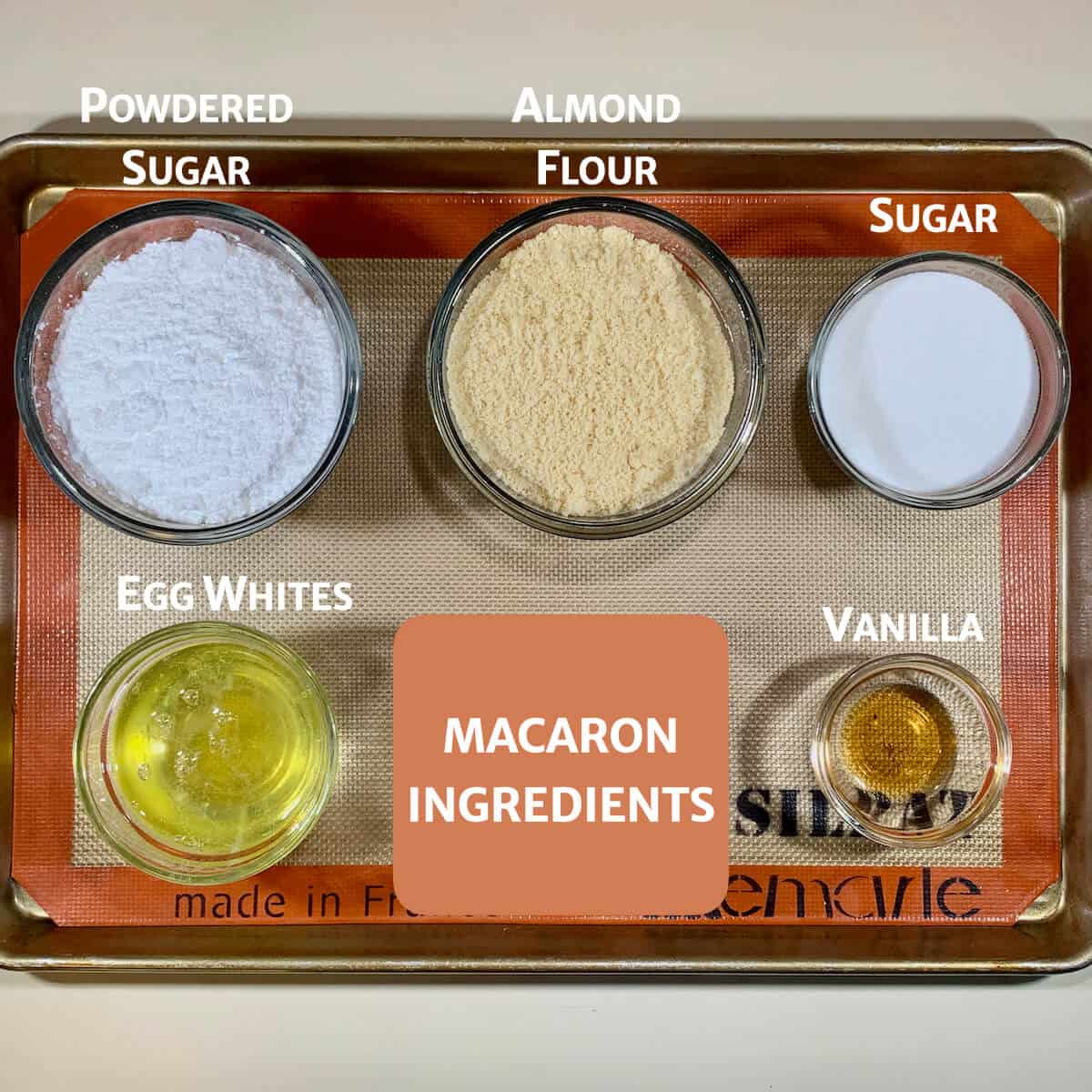
Ingredient Notes
Egg whites: For a successful meringue, the egg whites need to be absolutely free of fat to whip. To make sure there is no yolk, I suggest you separate the eggs over a bowl and dump the whites into another bowl (an egg separator can help). Also, wiping the mixing bowl with white vinegar or lemon juice prior to adding the whites helps to ensure there is no fat in the bowl that can inhibit the meringue formation. This step is optional but highly recommended.
Room-temperature egg whites whip up better than cold egg whites. For room temperature eggs, leave them out on the counter for 1 hour or submerge them in warm water for 5 minutes.
Almond Flour: There are two types of almond flour available, blanched and unblanched, the difference being whether or not the almonds are ground up with their skins. If the color of the macaron is going to be light, use the lighter-shaded blanched almond flour. Note, almond flour is not almond meal. You want the finer grind of the flour for this recipe.
Cream of tartar (not pictured): An acidic dry powder that's a byproduct of winemaking. It's used to stabilize the egg whites as they're being whipped, so you get a fluffier finished meringue. It's optional, but recommended.
Flavorings: You can flavor your Italian macarons with extracts other than vanilla. Use ¼ teaspoon for stronger flavors like almond, mint, or Fiori di Sicilia (an orange vanilla extract).
Coloring: If you want to color your buttercream, gel food coloring works best because it won't thin the product. The color does fade as it bakes, so do a shade or two darker than you want them to be.
Fillings: You have many options for filling the macarons. See below for some ideas.
See the recipe card for a full list of ingredients and measurements.
Macaron fillings are up to you
You’ll notice I didn’t include a filling recipe because there you can get creative. Here are some ideas to get you started:
- Buttercream: Make a classic buttercream frosting or an Italian meringue frosting in a complementary flavor and color
- Chocolate: A whipped chocolate ganache makes an intense filling flavor
- Caramel: Likewise, a thick caramel sauce can be spread on warm, then cool to set
- Cookies & cream: Place Oreo cookies with their filling in a food processor until smooth and creamy
- S'mores: Use crushed graham crackers, melted marshmallow, and chocolate ganache
- Other ideas: fruit curds, homemade jam, peanut butter...the list goes on.
How to make Italian macarons
As I said earlier, the only difference between a French macaron recipe and an Italian Macarons recipe is using the Italian meringue method. Past that, the steps are the same.
Step 1: Mix the almond flour and powdered sugar
To make macarons, first mix finely ground almond meal and powdered sugar (preferably passing them both through a fine-mesh strainer or sifter). Then fold in two egg whites to form a paste (photo 1).

Step 2: Make the sugar syrup
Remove 1 tablespoon of sugar and set aside for preparing the meringue.
Heat the remaining granulated sugar with ¼ cup water in a small saucepan. Place the pan over medium high heat and bring to a boil. As with making caramel, sugar can crystalize if stirred while boiling, so just leave it alone.
Heat the sugar syrup to firm-ball stage, between 248°F to 250°F (photo 2). It's best to use a digital thermometer or candy thermometer to be precise. If the syrup is done before the meringue is ready, add a very small amount of hot (not cold) water to lower the temperature slightly.
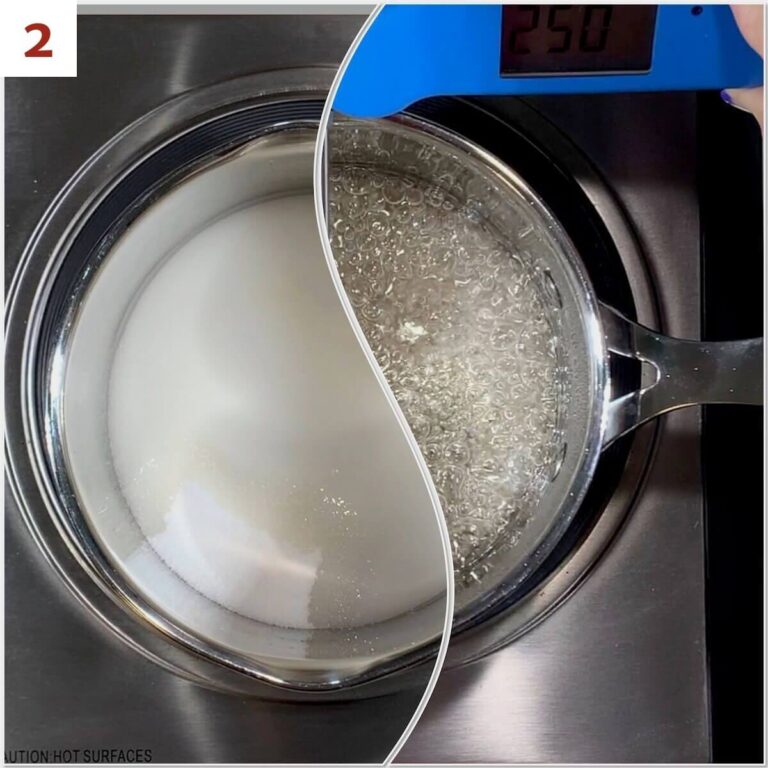
Step 3: Whip the egg whites
As soon as the sugar syrup starts to boil, it's time to start whipping your egg whites. When they're frothy, add the cream of tartar (if using) and 1 tablespoon of sugar, then whip them to stiff peaks (photo 3).
Don’t overwhip or the meringue can start to separate. If it’s ready before the sugar is to temperature, turn the mixer to the lowest speed and let it continue to run.

Step 4: Slowly stream in the sugar syrup
When the syrup and meringue are both ready, pour the hot syrup into the meringue in a thin, steady stream along the side of the bowl while the mixer is running (photo 4). This is now Italian meringue, and will be beautifully thick and glossy.
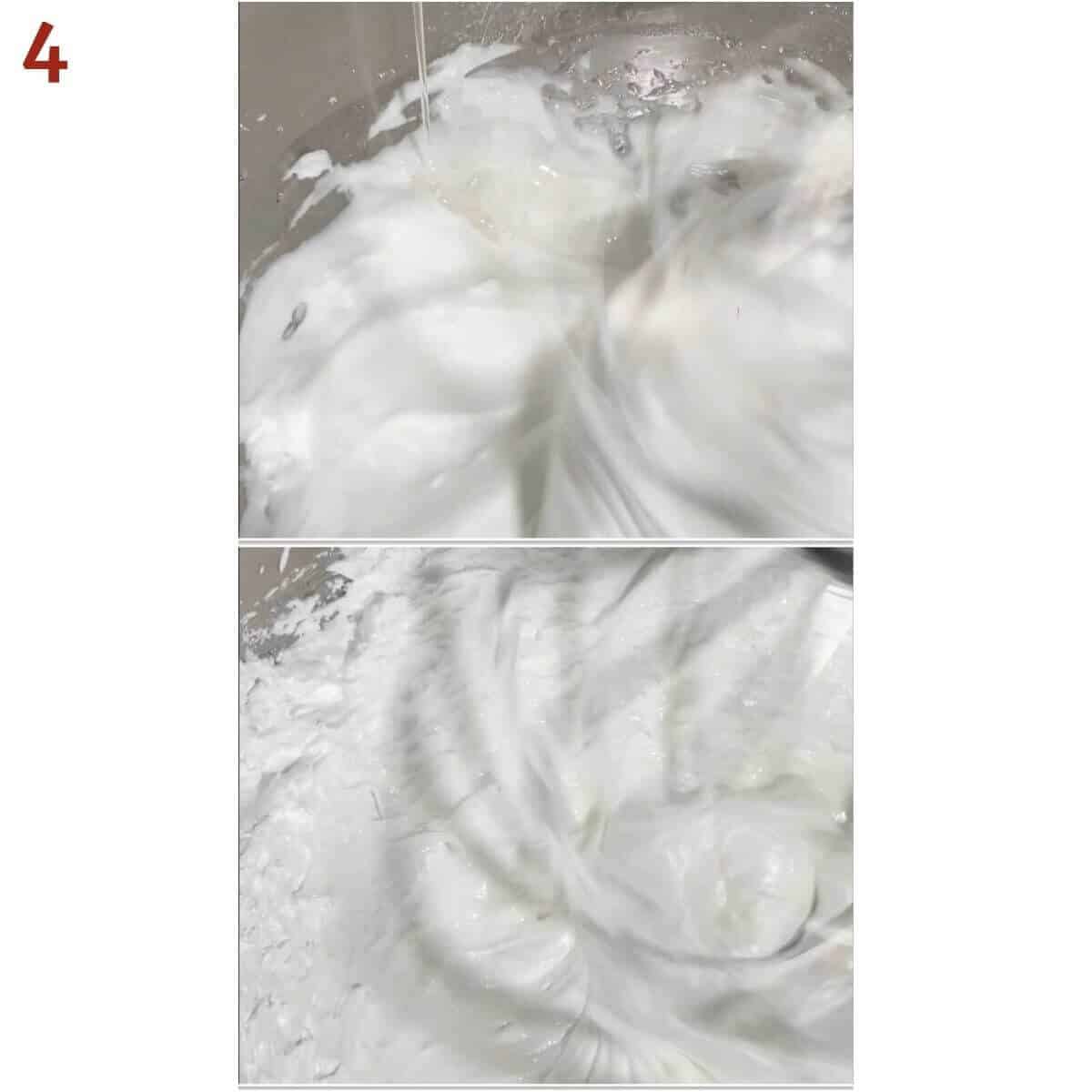
Step 5: Fold in the almond flour mixture
Gently fold the meringue into the almond paste mixture, being careful not to overmix the batter (photo 5).

Step 6: Portion the macarons
Line a half sheet baking pan lined with a Silpat silicone mat or parchment paper.
Transfer the macaron batter to a piping bag fitted with a ½-inch round pastry tip. If you're using parchment paper, place a little of the macaron batter on the underside of each corner to hold it flat to the baking pan.
Pipe out 1½-inch rounds onto the baking pan, spacing them about 1-inch apart. Tap the pan hard at least 2 to 3 times to release the air bubbles. This will prevent the tops of the macarons from cracking.
The batter needs time to dry
Allowing the macaron batter to dry before going into the oven is a very important step. When they dry out they can't spread out in the oven, and are forced to rise up. That's what creates the distinctive feet you want!
Let the macarons sit out for 30 to 60 minutes, allowing them time to dry out a bit before hitting the hot oven. They should be tacky, but not stick to your fingertips.
Step 7: Bake the macarons
After they've dried and formed a skin, bake the macarons at 325°F for 12 to 14 minutes (photo 6). Turn off the oven once the shells are done without opening the oven door to let them cool completely in the oven (about 1 to 2 hours) before removing the pan. This will keep them from cracking due to thermal shock.
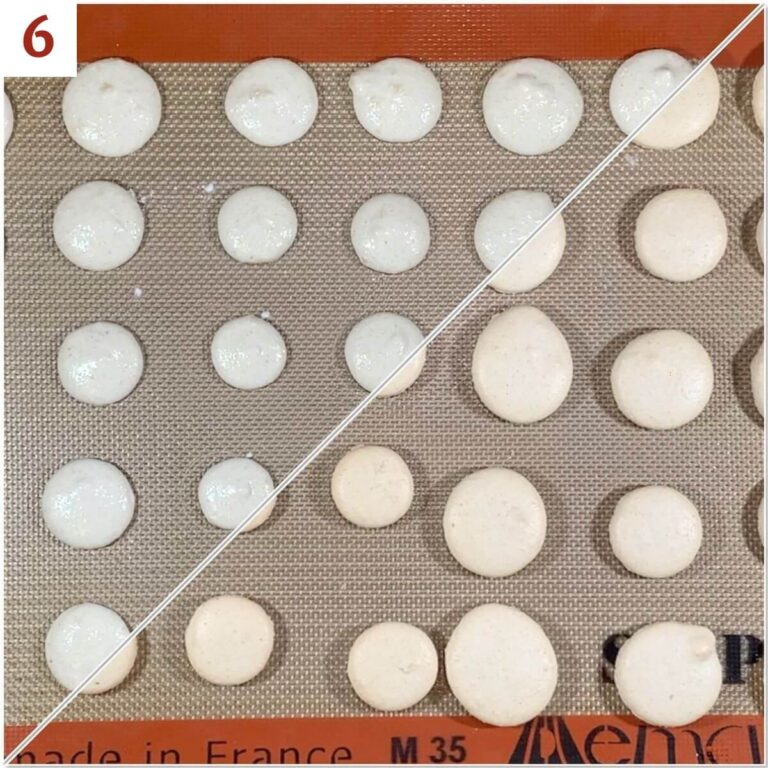
Storage and make-ahead instructions
These dainty treats are nice and crispy when you first sandwich them with the filling. However, macarons are best enjoyed the next day as the meringue shells have a chance to soften to a crispy chewiness.
Storage instructions: Filled Italian macarons can be stored in an air-tight container at room temperature for up to a week, unless you have a filling that must be refrigerated.
And packed well, Italian macarons can be shipped, allowing you to treat someone you love wherever they made be. Ready to ship, Italian macarons can make faraway family and friends happy!
Make ahead instructions: Italian macaron shells can be frozen in an airtight container for up to two months. There's no need to thaw them first before filling.

Tips for Italian macaron success
There are a few things you can do to ensure your macarons will be successful:
- Be patient when you sift the powdered sugar and almond flour together. This step can be tedious (especially if you don't have a sifter), but it's important to make the powder as smooth as possible and remove any larger almond pieces that would make the shells look less than ideal.
- Be careful when folding in the almond flour and sugar mixture into the meringue. You want to keep as much air in the meringue as possible because that's what causes the macarons to rise in the oven. Be diligent and count carefully.
- Allow the meringue shells to dry before going into the oven. When they dry out, the shells can't spread out in the oven, and are forced to rise up (that's what creates the feet). And it's such a good feeling when you have success!

Questions asked and answered
Here are some questions that you might have...
In general, a meringue is a mixture of whipped egg whites with sugar. There are three types of meringue: French, Italian, and Swiss. Each type varies based on preparation, texture, and stability.
The easiest type of meringue to make is a French meringue, i.e. egg whites beaten until fluffy and sweetened with sugar. When baked, French meringues are firm, yet fragile and crumbly. French meringues are used in desserts like Pavlova or Eton Mess, and also form the basis for French Macarons.
In Italian meringue, the sugar is boiled into a syrup before adding it to the whipped egg whites. As it's slowly added to the bowl, the egg whites cook, giving the resulting meringue a sturdier structure that's less brittle than French meringue. When baked, Italian meringues have a softer, marshmallowy texture. In fact, Marshmallow Creme (aka Marshmallow Fluff) is a form of Italian meringue. This Italian merigue method can also be used as the base for buttercream frosting.
There's also Swiss meringue, where the egg whites and sugar are slowly heated together so that the sugar dissolves fully into the egg whites. Then the mixture is whipped until light and fluffy. Its texture is softer, yet denser than an Italian meringue, and can be used in the same ways as the others. In terms of structure, Swiss meringue falls between the French and Italian versions.
You can make macarons using a French, Swiss, or Italian meringue. All will give good results, although the Swiss and Italian meringues are more stable, thus assuring the meringue shells will be light and airy.
There can be a number of reasons for hollow macaron shells: (1) The eggs were too fresh - relaxing the egg protein by letting the egg whites rest in the refrigerator for a day or two will help; (2) There could have been air trapped in the batter - that's why we tap the pan before baking; (3) The oven might be too hot - reduce the temperature 25˚F next time.
Yes! There's a vegan version of Italian meringue macarons in Kim Joy's Bake Me a Cat cookbook. In fact, most of the recipes in the book can be made vegan, and her first book had several vegan recipes as well.
There was also a baker on the Great British Baking Show who was vegan, Freya Cox, and she published a cookbook called Simply Vegan Baking. Check out this article about her and some other new vegan shows and challenges.

Recipes using egg yolks to try
Recipe

Italian Meringue Macarons
Equipment
Ingredients
- ¾ cup powdered sugar
- 1⅔ cup almond flour, see Recipe Notes
- 1 teaspoon white vinegar, or lemon juice, optional, see Recipe Notes
- 4 large egg whites, divided, at room temperature, see Recipe Notes
- ¾ cup granulated sugar, divided
- ¼ teaspoon cream of tartar
- 2 teaspoons pure vanilla extract, see Recipe Notes
- food coloring, optional, see Recipe Notes
- fillings, see Recipe Notes
Instructions
- Line a half sheet baking pan with a Silpat silicone mat or parchment paper.
- In a medium bowl, sift together the powdered sugar and the almond flour. Discard the larger lumps of almond pieces left behind, or have them as a snack.
- Add 2 egg whites (70 grams) to the sugar mixture and stir to form a paste. Cover the bowl with plastic wrap and set aside.
- Wet a paper towel with white vinegar or lemon juice and wipe the bowl of a stand mixer. Place the remaining egg whites in the bowl and fit the mixer with the whisk attachment.
- Remove 1 tablespoon of sugar and set aside for preparing the meringue. Heat the remaining granulated sugar with ¼ cup water in a small saucepan. Place the pan over medium high heat and bring to a boil. As with making caramel, sugar can crystalize if stirred while boiling, so just leave it alone.
- When the sugar starts boiling, begin beating the egg whites on a medium speed until frothy. Sprinkle in the cream of tartar (if using) and the 1 tablespoon sugar. Increase speed to medium high and beat until stiff peaks form. Don’t overwhip or the meringue can start to separate. If it’s ready before the sugar is to temperature, turn the mixer to the lowest speed and let it continue to run.
- Continue boiling the sugar syrup until it reaches 245 °F. Once it's to temperature, turn the mixer to medium-low and slowly start to stream the sugar syrup down the side of the bowl. Once all the syrup is added, turn the speed back to high and continue beating until stiff peaks form. Stir in vanilla and food coloring, if using.
- Gently fold the meringue into the almond paste mixture, being careful not to over-mix the batter. Transfer the batter to a pastry bag fitted with a ½-inch round pastry tip.
- If you’re using parchment paper, place a little of the macaron batter on the underside of each corner to hold it flat to the baking pan. Pipe out 1½-inch rounds onto the baking pan, spacing them about 1-inch apart.
- Tap the pan hard at least 2 to 3 times to release the air bubbles. This will prevent the tops of the macarons from cracking.
- Let the meringue shells sit out for 30 to 60 minutes, allowing them time to dry out and form a skin before hitting the hot oven. They should be tacky, but not stick to your fingertips.
- While the macarons are drying, preheat the oven to 325 °F.
- Bake the meringue shells for 12 to 14 minutes. Turn off the oven once the shells are done without opening the oven door to let them cool completely in the oven (about 1 to 2 hours) before removing the pan. This will keep them from cracking due to thermal shock.
- Macarons are best enjoyed the next day as the meringue shells have a chance to soften to a crispy chewiness.
- Storage instructions: Filled Italian macarons can be stored in an air-tight container at room temperature for up to a week, unless you have a filling that must be refrigerated.
- Make ahead instructions: Italian macaron shells can be frozen in an airtight container for up to two months. There's no need to thaw them first before filling.

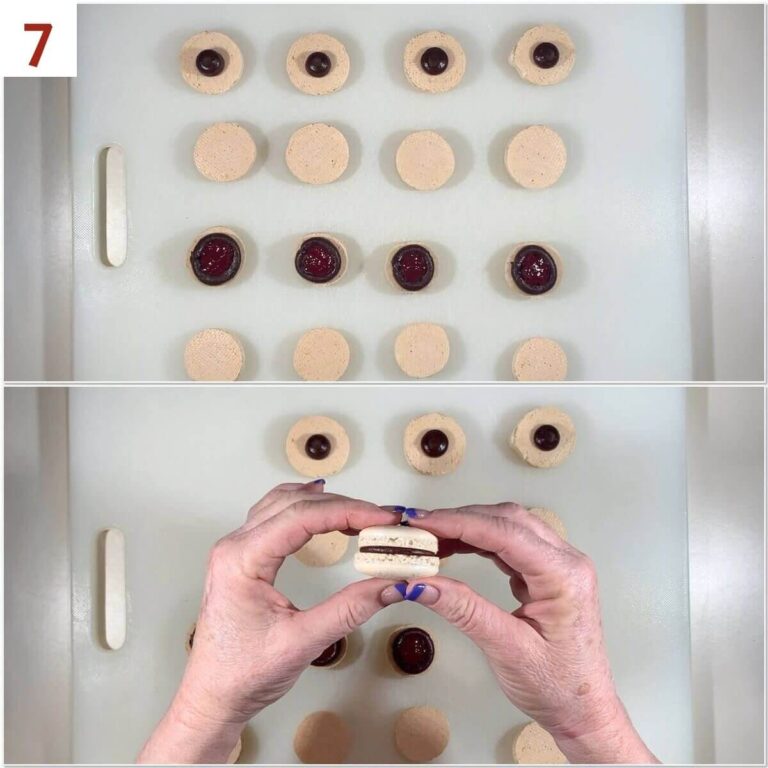




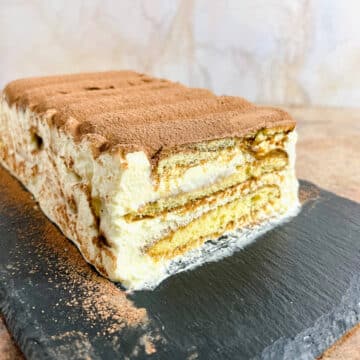


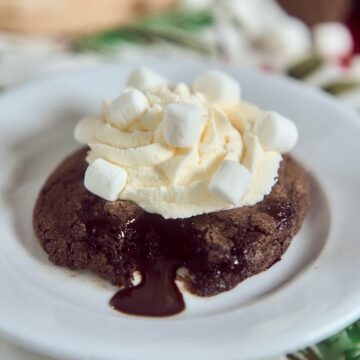
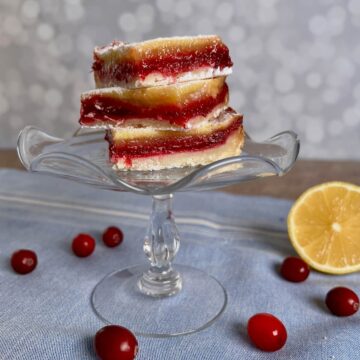
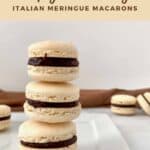

Ella says
Simply the best and most reliable way to make macarons! With french meringue macarons in the past I had maybe a 30-40% success rate, but so far I've made these three or four times and it has always worked! I even made a chocolate version by mixing in dark cocoa powder and they were delicious!
Tammy Spencer says
I'm so glad you found success! Thanks for sharing, and happy baking! 🙂
Harsha Sharma says
Hi! I love how informative and great your articles are. Can you recommend any other blogs that share blogs that share information on Vegan Coffee or vegan recipes in general? Thanks a lot!
Tammy Spencer says
Hi Harsha, Thanks for your kind words. I don't have any specific relationships with vegan food blogs, but a reader alerted me to 2 vegan bakers. See the FAQs for more detail. Happy baking! 😉